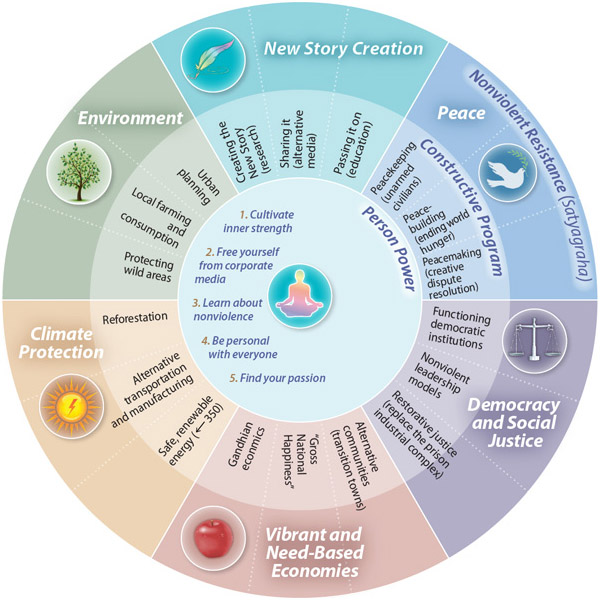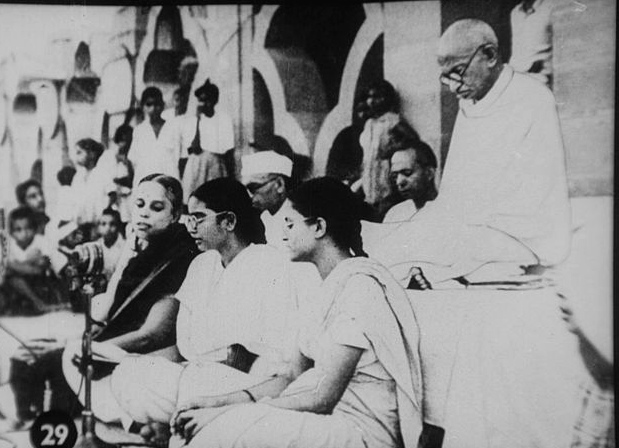by Ken Butigan
Awash in the churning tsunami of violence that crashes through our world almost hourly — in the last week of September and the first week of October 2013 it included the unspeakable suicide bombings in Peshawar, the terror attack on the Westgate Mall in Nairobi, and the horror of a mass shooting on a basketball court in Chicago — it is difficult to believe that violence does not firmly and implacably hold the upper hand. But we are living in a time — and in part precisely because of the catastrophic violence we face— when people everywhere, either out of desperation or a miraculously incongruous sense of hope, are turning to the nonviolent option. In spite of everything, a swelling movement across the planet is moving methodically forward with a mysterious confidence in the possibility of a third way.
Read the rest of this article »
by Metta Center for Nonviolence

The Metta Center Roadmap
From Zuccotti Park to Tahrir Square, a groundswell of popular discontent has arisen to confront the menacing problems and deplorable injustice of the present world order. It is clear, however, that these manifestations were just the beginning. Roadmap is a way to get “from spontaneous protest to unstoppable movement”, to address the deepest underlying issues that cry out for change in a concerted way without sacrificing the creativity and verve of Occupy and similar movements around the world, and a way that can include many who have so far not been physically active.
Roadmap, the result of years of work and many conversations in Metta’s Friday “Hope Tanks,” board meetings, and other venues, incorporates key elements of the great successful nonviolent campaigns of Gandhi, Martin Luther King, Jr., and others. It is primarily designed for those who feel as we do that the “Great Turning” toward a world of peace and justice, of environmental sustainability and the possibility of fulfillment for every human being, deserves and requires commitment to the “long haul.”
Read the rest of this article »
by Stephanie Van Hook

Gandhi in prayer c. January 1948, shortly before his assassination; photographer unknown; courtesy of commons.wikimedia.org
I am praying for the light that will dispel the darkness.
Let all those with a living faith in nonviolence join me in this prayer.
M.K. Gandhi
Gandhi was once given a seemingly impossible scenario: what would he do if a plane were flying over his ashram to bomb him? He rose to the challenge with an equally challenging answer: he would pray for the pilot. Some may take Gandhi’s response as preposterous. I argue, however, that his call to prayer was consistent with his vision of nonviolent strategy, for at least three reasons.
Reason 1: It meets the escalation of physical force with soul force.
Nonviolence requires strategic thinking; in other words, it requires a knowing of how to switch from one mode of operation to another in response to how the conflict is progressing. When a conflict escalates, a strategic response should also be prepared to escalate, not just with new tactics, but also through the depth of the nonviolence itself. Dr. King echoes this idea in his Dream speech, that the freedom struggle would meet “physical force with soul force.”
Read the rest of this article »
by Nathan Schneider
A year ago around this time, Occupy Wall Street was celebrating Advent — the season when Christians anticipate the birth of Jesus at Christmas. In front of Trinity Church, right at the top of Wall Street along Broadway, Occupiers set up a little model tent with the statuettes of a nativity scene inside: Mary, Joseph, and the Christ child in a manger, surrounded by animals. In the back, an angel held a tiny cardboard sign with a verse from Luke’s Gospel: “There was no room for them in the inn.” The reason for these activists’ interest in the liturgical calendar, of course, was the movement’s ongoing effort to convince Trinity to start acting less like a real estate corporation and more like a church, and to let the movement use a vacant property that Trinity owns.
A year later, even as a resilient few continue their 24-hour vigil on the sidewalk outside Trinity, churches and Occupiers are having a very different kind of Advent season together. Finding room in churches is no longer a problem for the movement.
Read the rest of this article »
by John David Muyskens
A commercial on TV shows a fierce looking man who says, “Why we fight is like asking why leaves fall. It is just our nature.” And that seems to be the nature of many people. But we can gain another nature.
We seem to be wired to try violence as a way to deal with violence. But violence only leads to more violence. If we can learn the art of love we will be able to get along so much better. We have a tendency to rush to judgment about people. We so quickly think ourselves better than others. But in reality we are all in the boat of life together.
One way to gain a loving nature is a form of contemplative prayer, called “Centering Prayer,” engaging us in silent, communion with God. In contemplation, we enter a presence rather than asking for anything. We accept the way things are. Centering Prayer changes us because for the moment we lose control. We are quiet. We let God give us whatever God wants to give. Not what we expect but what God gives. We give our consent to God’s presence and action in us. It is not a matter of doing but of being.
Read the rest of this article »
by Simon Moyle
Those who attempt to work for social change, especially in terms of peace work, are no strangers to despair. The task can seem so great, and our efforts so small, that victories seem impossible, the problems insurmountable. People’s attitudes take forever to change, if they change at all. Malevolent forces seem to have all the power, the weapons, the resources, the inertia, the media, and even the culture captive. Many refuse even to begin the work for this reason.
Gandhi also noted this fact in his book Hind Swaraj (or Indian Home Rule) in a section I think it is worth quoting at some length. In it he explains why he believes that the force of “love” (which he says “is the same as the force of the soul or truth”) is the greatest power in history:
“The fact that there are so many still alive in the world shows that it (satyagraha) is not based on the force of arms but on the force of truth or love. Therefore, the greatest and most unimpeachable evidence of the success of this force is to be found in the fact that, in spite of the wars in the world, it still lives on. Thousands, indeed tens of thousands, depend for their existence on a very active working of this force. Little quarrels of millions of families in their lives disappear before the exercise of this force. Hundreds of nations live in peace. History does not and cannot take note of this fact. History is really a record of every interruption of the even working of this force of love or of the soul…History, then, is a record of an interruption of the course of nature. Soul-force, being natural, is not noted in history.”
Read the rest of this article »






